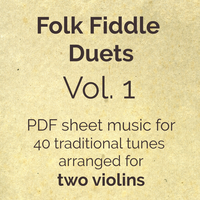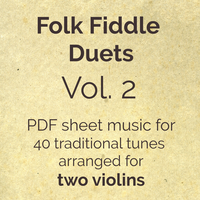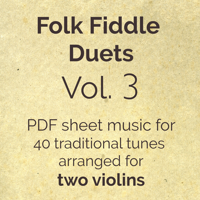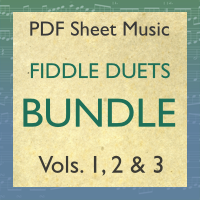Folk Fiddle Duets Vols. 1, 2 and 3 are all packs of 40 popular traditional fiddle tunes arranged for fiddle duet. The first violin plays the melody, and the second violin plays a harmony part.
I've been playing harmony parts in folk sessions for many years, which originally came from being a violist and not being able to easily reach the high notes in the fiddle tunes. However, I later obtained a violin, and found that while I was enjoying my newfound ease in playing the melodies, the harmony habit had stuck!
These collections include some of the harmonies I invented while playing in traditional music sessions, and some that are newly composed.
There are 40 duets in each pack, mostly tunes from the traditions of Scotland and Ireland, and a few from the English traditions.
You can buy each volume separately, or all of them together in a bundle at a discounted price.
There's a list of all the tunes included on the information pages for Volume 1, Volume 2 and Volume 3, where you can also see examples of the scores.
Fiddle Duet Demo Videos
See more on my folk arrangements YouTube channel.
What Makes a Good Fiddle Duet?
Playing harmony parts on a second fiddle is a fairly new addition to the traditional folk music of the British Isles. What are the best ways to do this sensitively and while maintaining continuity with the tradition?
The most important thing to keep in mind, in my opinion, is that in a fiddle duet the harmony part is there to enhance and support the melody, rather than to distract from or overpower it. In the fiddle duets in my sheet music, the harmony part is largely homophonic (playing the same rhythm as the melody) and sits below the melody, allowing the melody to still dominate the overall sound while the harmony adds interest and colour.
However, this is not the only way to accompany a melody in a fiddle duet. Another technique you could experiment with is playing double-stopped chords, using the chord symbols written above the melodies. These can either play slow or static parts, or add rhythm. These chords can be simple diads using two strings at once (and I find that incorporating an open string as often as possible works best, both for ease of tuning and for creating a nice resonance). Some players play a more complex rhythmic part in their chordal fiddle accompaniments, by holding down their fingers to create a full chord across all four strings, like you would on a guitar, and alternating which strings they play on while creating a rhythm with the bow, or even holding the instrument like a guitar and plucking.
As traditional melodies are often played several times through, there’s plenty of scope for incorporating several of these techniques in a fiddle duet arrangement of a single melody, if you want to. Or if you want to keep things simpler, you could just pick your favourite technique and stick with it.
With two violinists playing together in a duet, you have the option to alternate who is playing the melody and who is playing the harmony. So if one player likes playing a harmony part that follows the rhythm of the melody, such as those in my sheet music, and the other prefers playing rhythmic chords, you can switch between melody and accompaniment between you and develop a complex arrangement without either player having to cover every technique.
Or, in the opposite situation, you might have one player who likes to only play the melody and never play anything else – and another who loves experimenting with all the different accompaniment techniques but shies away from the responsibility of holding the melody down (that would be me…). This can also lead to an interesting and complex fiddle duet arrangement, while letting both players stay in their comfort zones. And, in this situation, should either player wish to venture beyond their comfort zone, it means there’s someone on hand to show them how it’s done: playing fiddle duets can be a fun social activity, something to perform to an audience, and/or a pathway to musical development.




